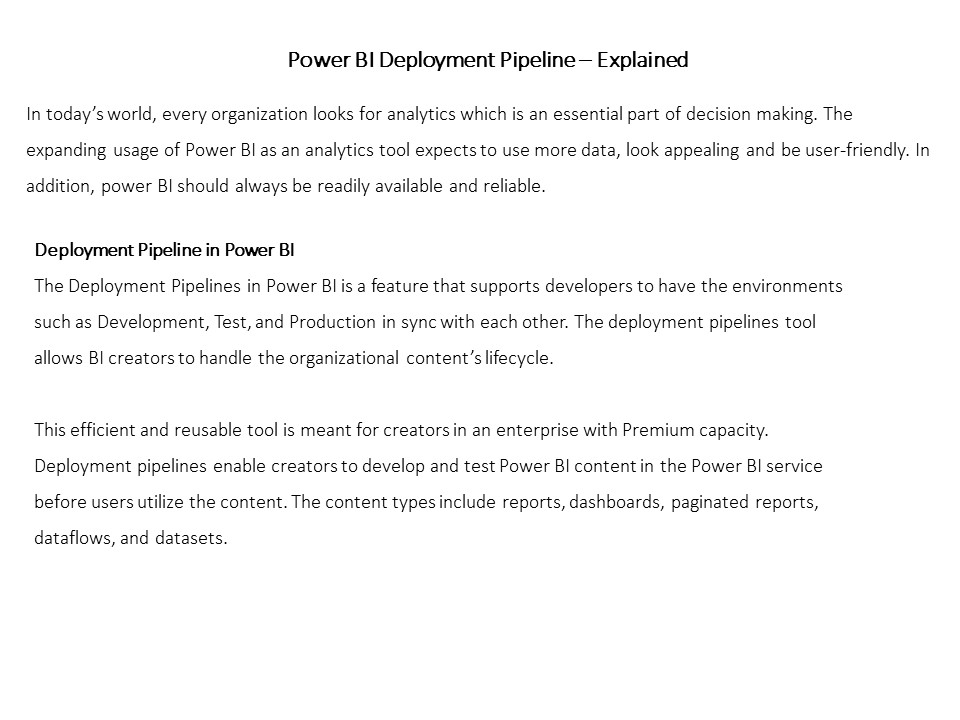Power BI Deployment Pipeline – Explained - PowerPoint PPT Presentation
Title:
Power BI Deployment Pipeline – Explained
Description:
The Deployment Pipelines in Power BI is a feature that supports developers to have the environments such as Development, Test, and Production in sync with each other. The deployment pipelines tool allows BI creators to handle the organizational content’s lifecycle. – PowerPoint PPT presentation
Number of Views:20
Title: Power BI Deployment Pipeline – Explained
1
Power BI Deployment Pipeline Explained
In todays world, every organization looks for
analytics which is an essential part of decision
making. The expanding usage of Power BI as an
analytics tool expects to use more data, look
appealing and be user-friendly. In addition,
power BI should always be readily available and
reliable.
Deployment Pipeline in Power BI The Deployment
Pipelines in Power BI is a feature that supports
developers to have the environments such as
Development, Test, and Production in sync with
each other. The deployment pipelines tool allows
BI creators to handle the organizational
contents lifecycle. This efficient and
reusable tool is meant for creators in an
enterprise with Premium capacity. Deployment
pipelines enable creators to develop and test
Power BI content in the Power BI service before
users utilize the content. The content types
include reports, dashboards, paginated reports,
dataflows, and datasets.
2
The tool is designed as a pipeline in three
stages which include Stage 1 Development This
first stage in the deployment pipeline is
Development. This stage is used to design, build,
and upload new innovative content with the
support of fellow creators. Stage 2 Test The
test is the second stage in the deployment
pipeline. First, enter the test stage after
making all the required corrections to your
content. Then, upload the corrected content so it
can be shifted to this test stage. Consider three
examples that explain what can be done in the
test environment Share your content with testers
and reviewers Load and run tests with high
volumes of data Test your app to check how it
will be displayed for your end-users Stage 3
Production The third stage after testing the
content is the Production stage. Here, use the
production stage to share the final version of
your content which has undergone the test stage,
with business users across the organization.
3
- Considerations of Deployment Pipeline
- Take a moment to understand the list of
considerations before getting started with the
Power BI Deployment Pipelines setup. The
considerations include, - You or your organization should first hold
a Power BI Premium account to use Deployment
Pipelines. - It is not mandatory to have all three
environments. Instead, it works well with two
also. If you have just two, you can go for Test
and Production pipelines. - The feature supports backward deployment as well.
Hence, you can deploy it backward and set up the
pipeline if you already have a controlled
production environment. - The feature is not limited to any sequential
orders. Therefore you can deploy with any order
as per your requirement. - Power BI has released REST APIs for the
deployment pipelines, which offers you the
ability to automate the syncing as well. - The Deployment Pipeline feature currently doesnt
support all data sources.
4
Prerequisites for Power BI Deployment
Pipeline The prerequisites for Power BI
deployment pipelines setup are as follows Power
BI Premium Account It is a must for you to have
a Power BI premium account. Any of the following
cases might require the access to the Power BI
deployment pipelines feature An organizational
Power BI Premium capacity account, with a Pro,
account for the users where you will look for the
Pro account to publish reports from the Power BI
Desktop. Workspace Permissions The Deployment
Pipelines are built at the workspace level and
require the workspace to be a Premium workspace.
A premium workspace is created with a Premium
account. And you should be the admin of that
workspace. Data sources The Deployment Pipelines
feature supports data sources like Azure Analysis
Services, Azure Synapse, SSAS, Azure SQL Server,
SQL Server, OData feed, Oracle, SAP Hana import
mode, SharePoint, and Teradata. For data sources
apart from the above list, you can try using
parameters, if thats possible with your data
source.
5
- Limitations of a deployment pipeline
- It is essential to consider these several factors
before creating a deployment pipeline. - You should be an admin of the workspace before
assigning the workspace to a pipeline. - The workspace should also come under the category
of Premium capacity. - One workspace cannot be assigned to multiple
various pipelines a workspace can only exist in
one pipeline. - The list of unsupported items includes Datasets
not stemming from a PBIX, PUSH datasets,
Streaming dataflows, Goals, Excel Workbooks, and
Template app workspaces.































